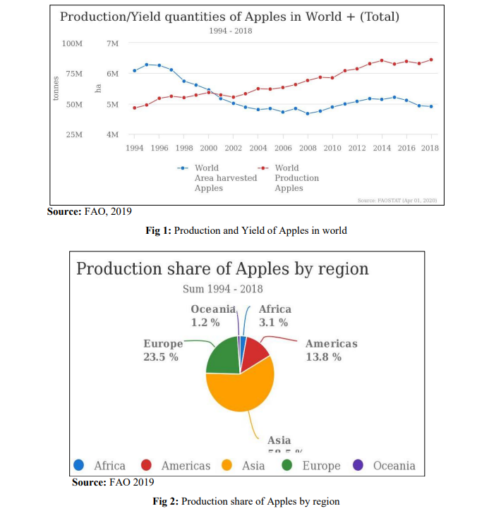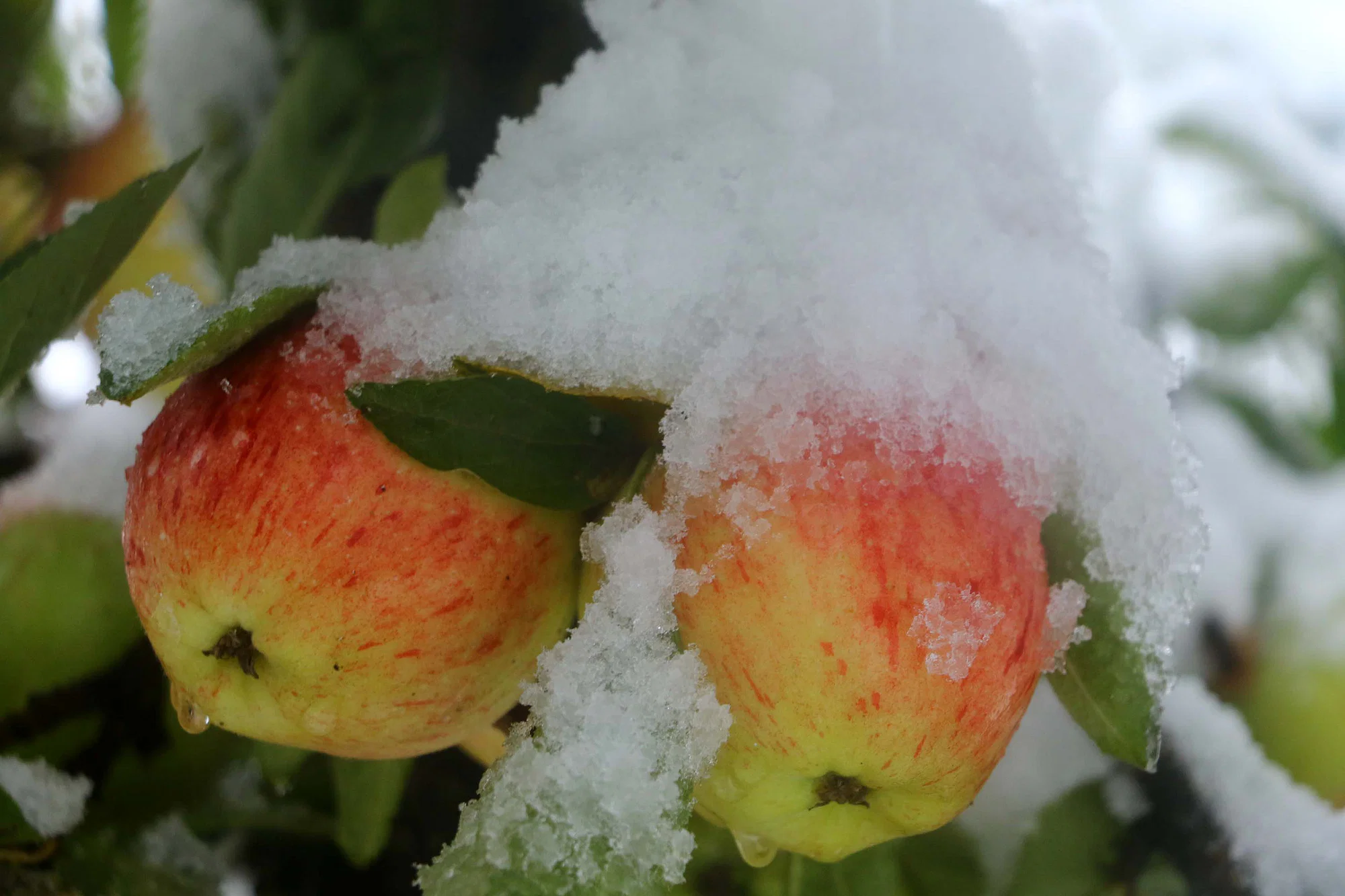The possibility of having no apple trees might have deprived the world of Newton’s laws of gravitation or Steve Jobs’ Apple Company. Who says the apple is just a fruit, it represents a paradigm shift in scientific thinking. This article is not going to excavate the technological or revolutionary history associated with apples rather this article is an attempt to assess the impact of climate change on the apple industry in Kashmir from an economic and livelihood perspective.
Climate change, a universal phenomenon, is a major concern for the food and nutritional security of the growing population, expected to be 9.5 billion by the end of 2050. Climate change as a whole is a term described as a shift in worldwide weather phenomena linked with an increase in global average temperatures, which may be due to external forcing or natural internal processes, or to the anthropogenic changes in the composition of the atmosphere or in land use.
With climate change already showing up its cataclysmic face no sector of the economy will be spared. Apple industry is one such sector in Kashmir that is facing the toughest challenges of extreme variations in weather, resulting in low productivity and profitability.
Imminent Challenges
The leading continents/countries for apple production are presented in Fig 1. Asia ranks number one in terms of the production of apples and China and India lead in production, yield, and area (fig 1). The production share of some regions is shown in Fig 2.

Almost 80% of India’s apples are grown in Kashmir but due to the early snowfalls in the valley farmers lose half their crops. Orchards in the Kashmir valley, which is encircled by the Pir Panjal and Greater Himalaya mountains, are predicted to become unsustainable in the next few years as the climate crisis affects crop output. Weather patterns in the region have gradually changed over the past twenty years, and they have worsened in the last five.
Unusual pattern of rainfall: According to the meteorological department of Jammu and Kashmir between March 1 and April 21, 2022, Kashmir received only 43 millimeter (mm) of rainfall against the average normal precipitation of 209 mm, indicating a deficiency of around 80%, which led to the drought-like situation. The region’s apple and other crops thrive on the rains at this time. In the first five months of 2022, J&K only received 345 mm of rainfall when it should have received an average normal rainfall of 559 mm. This indicates a deficiency of around 40%.
Unusual snowfall patterns: A recent study claims that climate change in the valley reveals that early summer winds were causing great damage to flowering fruit trees. A similar study finds that winter weather patterns have changed significantly, with recent snowfalls of less than one meter compared with more than two meters in previous years. Kashmir Valley’s Apple Orchards are facing adverse impacts of climate change. The valley has witnessed early snowfall due to which farmers have lost around 40% of their crops every year. The Kashmir valley experienced its first snowfall of the year in October 2021. The bulk of farmers hadn’t finished harvesting their crops at that time. According to researchers, 4 to 40% of the apple orchards and other produce were devastated.
A recent study portrays an abysmal picture of the apple industry. Research conducted by Irfan Rashid and others suggests that the apple orchards of the valley might not sustain if these climatic conditions prevail. Experts have plotted the snowfall distribution and snow depths during the snowstorm events in November 2018 and November 2019 by combining remotely sensed data and field observations. Using ERA-5 re-analysis climate datasets to investigate the causes of these erratic snowfall events points to an early arrival of Western Disturbances (WD) to the area, the paper claims. Satellite data analysis reveals that the apple orchards cover roughly 9.8% (1329 km2) of the entire surface of Kashmir Valley, out of which 32.6% were mild to severely damaged by snow.
Economic Loss
Apple cultivation is the mainstay of Kashmir’s economy (along with tourism and handicrafts) with revenue of ₹ 1,200 crore a year, as per the Associated Chambers of Commerce and Industry of India. Horticulture contributes over 8% to the Gross Domestic Product (GDP) of the Union territory.
Apple cultivation in India is dominated by Kashmir, which produces 78% of India’s total annual output of around 25-26 lakh metric tonnes (MT). The apple industry, which employs 3.5 million people and contributes 10% to Kashmir’s GDP, is the state’s largest employer, generating 400 man-days of labour annually per hectare.
From employment generation to being one of the biggest sources of livelihood in Kashmir, the apple industry plays a quintessential role in Kashmir’s economy. The area under apple cultivation has increased from 46,190 hectares to 1332,810 hectares between 1974 and 2009. However, production is currently in danger due to the region’s unusual storms, rain, and snowfall.
The areas in South Kashmir, with an estimated 264 km2 of damaged land, suffered the most from the unexpected snowfall, followed by North Kashmir (151 km2) and Central Kashmir (18 km2). Official data by Kashmir’s department of horticulture says, 5bn rupees were lost from harvests in 2018. This jumped to 22.5 billion rupees in 2019, the year Kashmir saw the most snowfall in 60 years. According to one of the studies, large economic losses related to the early arrival of Western Disturbances effectively brought the horticulture industry to a standstill in 2018 and 2019. The table underneath shows the apple production for 2018-19 and 2019-20.
Apple production for years 2018-19 and 2019-20
| Year | Production (in Mts.) |
| 1. 2019-20 | 147130 |
| 2. 2018-19 | 1851723 |
Source: Directorate of Horticulture, Kashmir
Adaptation and Mitigation: Italian species as alternative
The introduction of high-density Italian apple species has been proposed as a remedy for apple cultivation under the current climate challenge. In order to avoid the damage caused by an early snowfall, Kashmiri apple growers can now harvest the fruit in August rather than having to wait until October or November, thanks to the Italian high-density apple nursery.
In light of these findings, the state administration has been encouraging high-density plants. The government has expanded subsidies and programmes to aid the Italian nursery. The high-density nursery is nimble and begins bearing fruit in the second year of the plantation, whereas a standard apple tree could start bearing fruit after at least ten years. With only a few feet between each plant, plantations
occur in great density, increasing the density of yield. The apples are juicier than typical apples and have a deep crimson color. According to researchers, switching to high-density Italian could save the sector.
The use of drip irrigation, which aids in localized water distribution and directs water along constrained plant rows, is another crucial aspect of Italian orchards. The new orchard techniques, according to experts, have completely changed the game in terms of water conservation. The construction of the contemporary orchard, with its roof and irrigation system, does need some investment, but this can be offset by government incentives.
Conclusion
In India, apple is grown in Jammu & Kashmir, Himachal Pradesh, Uttrakhand, and Arunachal Pradesh, and these regions no longer remain unaffected by climate change. There is a dire need to develop adaptive strategies and look for climate-resilient apple cultivars. In this connection, apple cultivation is currently undergoing a significant shift from traditional to high-density, which involves an altogether different way of modern farming. The government has been promoting subsidy schemes to encourage farmers to buy and market new varieties. Nonetheless, eradicating the climate catastrophe from its source is more crucial and effective. Reliable weather forecasting technologies must be developed in order to overcome climate uncertainties.
References:
-
https://www.livemint.com/Politics/l5qJce3q8892Frz1IxHL4L/Apples-and-cl imate-change-in-Kashmir.html
-
https://www.theguardian.com/global-development/2021/nov/24/india-kashm iri-apple-farmers-climate-crisis-snow-decimates-crops
-
https://www.ucanews.com/news/climate-change-hits-apple-growers-hard-in- kashmir-valley/74826
-
https://zeenews.india.com/india/climate-fury-kashmir-s-apple-orchards-may- vanish-fear-researchers-2414615.html
-
https://theprobe.in/how-climate-change-is-hurting-kashmirs-apple-industry/
-
https://www.outlookindia.com/national/climate-change-in-kashmir-apple-far mers-reeling-under-extreme-weather-falling-yield-news-197050
-
-
https://thewire.in/agriculture/kashmir-apple-growers-rising-incomes-profits
- https://www.phytojournal.com/archives/2020/vol9issue5/PartQ/9-2-446-397.pdf



Leave a Reply
You must belogged in to post a comment.